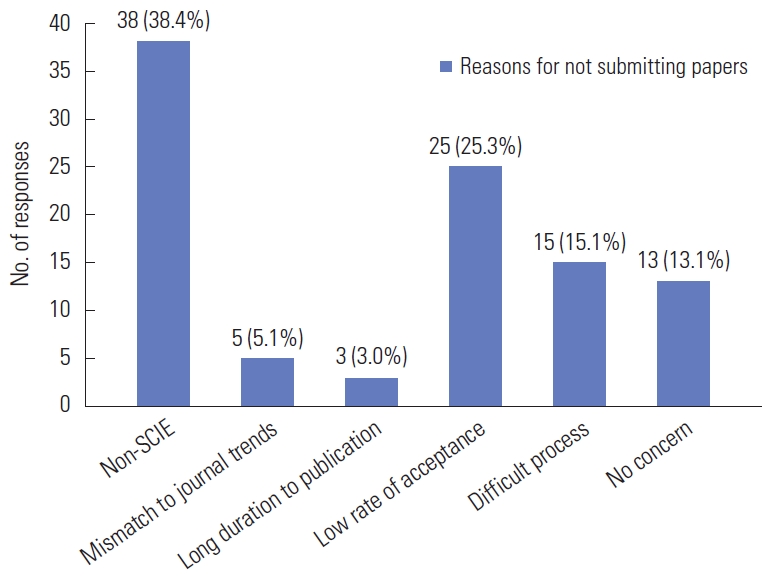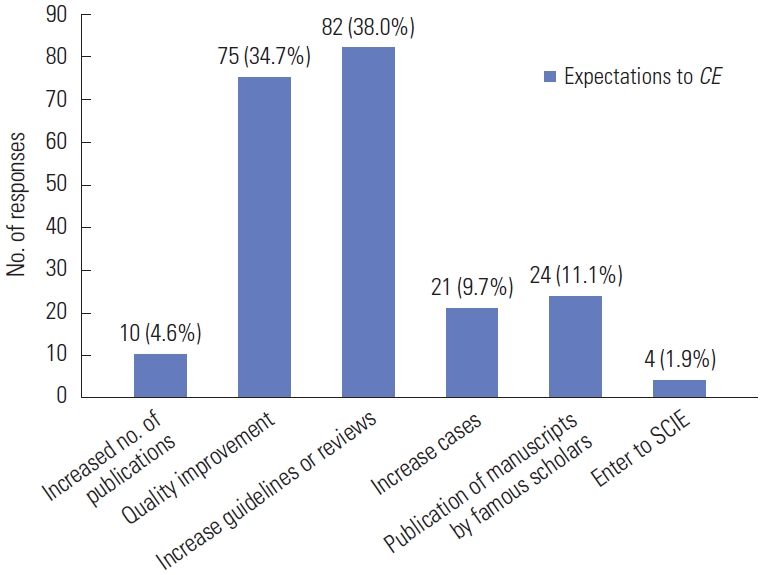Articles
- Page Path
- HOME > Sci Ed > Volume 10(2); 2023 > Article
-
Original Article
Current status and demand for the advancement of Clinical Endoscopy: a survey-based descriptive study -
Tae Hoon Lee1
 , Jimin Han2
, Jimin Han2 , Gwang Ha Kim3,4
, Gwang Ha Kim3,4 , Hyejin Han5
, Hyejin Han5
-
Science Editing 2023;10(2):135-140.
DOI: https://doi.org/10.6087/kcse.312
Published online: August 1, 2023
1Division of Gastroenterology, Department of Internal Medicine, Soonchunhyang University Cheonan Hospital, Soonchunhyang University College of Medicine, Cheonan, Korea
2Division of Gastroenterology, Department of Internal Medicine, Daegu Catholic University School of Medicine, Daegu, Korea
3Division of Gastroenterology, Department of Internal Medicine, Pusan National University Hospital, Pusan National University School of Medicine, Busan, Korea
4Biomedical Research Institute, Pusan National University Hospital, Busan, Korea
5Korean Society of Gastrointestinal Endoscopy, Seoul, Korea
- Correspondence to Tae Hoon Lee thlee9@schmc.ac.kr
Copyright © 2023 Korean Council of Science Editors
This is an open access article distributed under the terms of the Creative Commons Attribution License (https://creativecommons.org/licenses/by/4.0/), which permits unrestricted use, distribution, and reproduction in any medium, provided the original work is properly cited.
- 1,768 Views
- 223 Download
Abstract
-
Purpose
- This survey study aimed to investigate the current status, issues, and needs related to Clinical Endoscopy (CE), the official international journal of the Korean Society of Gastrointestinal Endoscopy (KSGE).
-
Methods
- A 10-item survey was emailed to domestic KSGE members between May 1 and May 15, 2023. The results were analyzed using descriptive statistics.
-
Results
- In total, 216 complete responses were analyzed. Most respondents (46.8%) read CE once or twice monthly. The proportion of respondents who read the journal once or twice a year or did not read it at all was quite high, at 36.6%. The most informative article type was review articles (53%), and the least-read type was editorials (33%). Ninety-nine respondents (45.8%) stated that they did not want to submit their articles to CE because CE is not a Science Citation Index Expanded (SCIE) journal (38.4%). Eighty-nine respondents (41.2%) did not cite CE articles in their manuscripts. Furthermore, 41.2% of the respondents declined review invitations because they were too busy (73.0%). The two most common requests for CE were to increase the number of guidelines and review articles (38.0%) and to improve the journal quality (34.7%).
-
Conclusion
- Although CE is a representative journal of KSGE, the level of interest and concern for CE among society members was relatively low. Nonetheless, this survey offers valuable insights into the needs and current status of CE, paving the way for its further development. It is clear that more efforts and investments from the society and the editorial board are necessary.
- Background and rationale
- The Korean Society of Gastrointestinal Endoscopy (KSGE) was established on August 14, 1976, and published its journal, Taehan Sohwagi Naesigyŏng Hakhoe chi (Korean Journal of Gastrointestinal Endoscopy, pISSN: 1225-7001) in Korean from November 1981 to July 2011. Since the September 2011 issue, the journal has been published in English under the official title, Clinical Endoscopy (Clin Endosc, CE; pISSN: 2234-2400, eISSN: 2234-2443).
- CE is currently the joint official journal of KSGE, International Digestive Endoscopy Network (IDEN), Vietnam Association of Gastroenterology (VNAGE)/Vietnam Federation for Digestive Endoscopy (VFDE), and Thai Association for Gastrointestinal Endoscopy (TAGE). IDEN is an international organization established by KSGE in 2019 to promote and share advances in digestive endoscopy research. VNAGE and TAGE officially designated CE as the official journal of the societies in March 2021. CE publishes peer-reviewed articles bimonthly and features original articles, state-of-the-art review articles, instructive case reports, brief communications, and letters to the editor on experimental, diagnostic, and therapeutic gastrointestinal endoscopy. CE was indexed in KoreaMed on September 22, 2011; PubMed Central (PMC)/PubMed on June 28, 2012; Scopus on November 11, 2013; EBSCO on June 29, 2015; Emerging Sources Citation Index (ESCI) on June 6, 2016; Directory of Open Access Journals (DOAJ) on April 28, 2018; and Embase on January 1, 2019.
- Although CE is a representative professional journal in the field of endoscopy, no survey has yet been conducted on awareness and concerns related to the journal among the general members of KSGE. A comprehensive investigation is needed to identify the specific requests that could further advance the development of CE. Thus, it is necessary to conduct an evaluation and analysis of the needs and current concerns of the domestic members of KSGE.
- Objectives
- This survey study aimed to better understand the perceptions of CE, including needs, among domestic members of KSGE. The study specifically explored the members’ interest in journal information, submission and citing behavior, participation as peer reviewers, and expectations for the journal.
Introduction
- Ethics statement
- This study was based on anonymous online survey results from society members, which included no sensitive personal information. Therefore, this study did not require approval from the Institutional Review Board.
- Study design
- This was a descriptive study based on an online survey.
- Data collection methods
- A survey consisting of 10 questions and five subquestions (Suppl. 1) was developed by the editors (THL, GHK) of CE and emailed to domestic KSGE members three times between May 1 and May 15, 2023, through Google Forms (Google). The survey questions consisted of basic information on the respondents (three items), interest in journal information (three items), submission and citing behavior (two items), participation as peer reviewer (one item), and expectations for the journal (one item). Initially, 221 responses were collected for analysis. Among them, five inadequate responses were excluded. Finally, 216 responses were analyzed.
- Participants and variables
- After sending the survey questionnaire to email addresses listed in the KSGE database, 221 responses were collected. There were no exclusion criteria, and the total target number was 8,659. All items of the survey questionnaire were analyzed as variables.
- Data analysis
- The study focused on analyzing the responses of domestic KSGE members concerning their interest, perceived usefulness, and expectations regarding CE. Descriptive statistical analyses were performed to evaluate respondents’ current concerns and trends. There was no selection bias. Sample size estimation was not done because this was a survey-based descriptive study conducted among domestic society members.
Methods
- Characteristics of the participants
- Among the 8,659 members of KSGE who agreed to receive emails from the society, 221 members (2.55%) responded. The basic demographic characteristics of the respondents are described in Table 1. Data on gender, age group, and working area were analyzed. Male physicians were predominant (81.5%), and the age group with the most respondents was people in their 50s. About 50% of physicians worked at a university or tertiary referral hospital. Raw response data are available from Dataset 1.
- Interest in journal information
- Questions 4 to 6 related to the frequency of reading CE, the most beneficial article type, and the least-read article type. About half of the respondents (46.8%) said they read CE once or twice monthly. The proportion of respondents who read the journal once or twice a year or did not read it at all was 36.6%. A common reason for not reading CE was that CE is not a Science Citation Index Expanded (SCIE) journal, but rather a domestic journal (Table 2). Considering that CE is published bimonthly, the reading rate was meager. The most informative article type was reviews (53%), followed by case reports (11%) and guidelines (10%). The most unnecessary or unread article type was editorials or commentaries (33%), followed by quizzes (27%), case reports (14%), and original articles (11%) (Fig. 1).
- Submission and citing behavior
- Regarding the submission of articles to CE, 99 respondents (45.8%) did not want to submit their articles to CE because CE is not an SCIE journal (38.4%), has a relatively low acceptance rate (25.3%), and has a difficult submission process (15.1%) (Fig. 2). The survey asked about whether authors cited articles from CE when preparing manuscripts for submission to SCIE journals. Eighty-nine respondents (41.2%) stated that they did not cite CE papers as references. The most common reason was that they did not know CE well, even though CE is the official journal of KSGE. Other reasons were that CE is not an SCIE journal, and some respondents also stated that there was no need because they did not write papers (Fig. 3).
- Participation as a peer reviewer
- In response to the question, “Are you willing to accept a review request from CE?” 41.2% of respondents stated that they would decline a review invitation because they were too busy (73.0%) or the review process was too difficult (10.1%) (Fig. 4).
- Expectations for CE
- The two most common requests for CE were an increased number of clinical practice guidelines and review articles (38.0%) and quality improvement (34.7%). The desire for an increased frequency of publication and becoming an SCIE journal was relatively low (Fig. 5). A minor opinion was that CE was less readable than before, when it was published in Korean.
Results
- Interpretation
- Although CE is the official journal of KSGE and there are over 8,000 KSGE members, a minimal number responded, and one-third of the respondents stated that they usually did not read CE. The most common reason was that CE is not an SCIE journal. Many members thought CE was only a domestic journal that had been converted into English. For the item asking which article types were the most useful, more than half of the respondents answered that review articles were the most beneficial and editorials (commentaries) were the least helpful type. Usually, review articles, guidelines, and meta-analyses provide information on recent trends and information to readers, so other journals also concentrate on these types of papers [1]. CE also needs more collaboration with other associated academies or journals to expand its scope. Editorials should emphasize experts’ perspectives on clinical benefits and experience-based opinions. However, editorials often describe or summarize the study results rather than offer unique viewpoints. Therefore, editorials should include more detailed analyses and criticism by experts.
- The most common reason for not submitting papers or not citing them was that CE is not an SCIE journal. Of particular note, many Korean universities include only SCIE journals when evaluating academic achievements. Therefore, there is a strong tendency to avoid submitting papers to non-SCIE journals as the first option. Becoming an SCIE journal is essential for attracting higher quality manuscripts. Therefore, more effort and investments from KSGE, including joint academic conferences, are needed. Eighty-nine respondents (41.2%) stated that they did not use CE papers as references. The most common reason was that they did not know CE well, even though it is the official journal of KSGE. It seems that more active publicity for CE is needed. Furthermore, some respondents said that acceptance was very difficult. This perception could be attributed to the notably low acceptance rate for case reports, which stood at just 6% in 2022. The overall CE acceptance rate was 45% in 2022. The mean time to acceptance was 62 days in 2022 and 14 days to rejection.
- Being busy was the most common reason for declining review requests. Thus, this result could be interpreted as indicating that the respondents had no strong interest in reviewing articles, and the fact that CE is not an SCIE journal was also an important reason.
- Importantly, many members requested an increase in the number of clinical practice guidelines or review articles and quality improvement. Therefore, high-quality review articles and clinical practice guidelines by experts and academic societies are required. Becoming an SCIE journal will increase the submission of higher quality original articles. Therefore, more efforts are needed to meet the needs of the KSGE members and improve the quality of CE. Attempts have recently been made to enhance the visual quality of communication using graphical abstracts and to conduct publicity through Facebook [2–4]. These efforts are expected to help improve the editing quality and raise awareness of CE, which were noted as problems in the survey results. Still, more communication with international researchers and investment by KSGE are needed to meet readers’ needs and concerns.
- Comparison with previous studies
- Similar studies have been conducted in the past. In 2020, a total of 310 members of the British Orthodontic Society participated in a survey. Among them, 230 (74.2%) indicated they read a minimum of one article from each issue. The Journal of Orthodontics received positive feedback, with 197 participants (63.6%) ranking it as excellent and 109 (35.2%) marking it as satisfactory. Members of the society found the journal to be pertinent to the current clinical practice and expressed a high level of satisfaction with it. Additionally, there was a notable demand for increased online engagement with the members as a part of the society’s role [5]. In 2013, an email containing a readership survey was distributed to all active members of the Aerospace Medical Association. The members expressed a preference for the publication of more clinical articles, and the journal was committed to addressing that goal [6]. An international email survey was conducted among authors who published articles in five general surgery journals (Annals of Surgery, British Journal of Surgery, World Journal of Surgery, Archives of Surgery, and Surgery) between January 1, 2007, and December 31, 2008. The survey found that the journal’s reputation was deemed “very important” (5 points) by 62% of the respondents. This was closely followed by the journal’s impact factor, which was considered “very important” by 61% of the participants. When combining several factors into categories, the journal’s prestige and turnaround time were identified as the most critical attributes [7]. A survey was distributed to a random selection of 1,000 domestic members of the British Dental Association, from whom 587 completed questionnaires were collected. That year, the “News” section of the British Dental Journal was the most widely read, followed by “Research summaries.” Readers expressed a desire for a greater emphasis on practical clinical techniques and “How to do it” articles, and less emphasis on nondental-related topics [8]. The topics of the above earlier reports are not exactly the same as those of the present study. However, a major incentive to submit the research results was a journal’s prestige, and the most society members read at least one article per issue in the society journals.
- Limitations
- This survey study was based only on descriptive statistical analyses. Thus, the results showed the current state of concerns regarding CE among respondents. However, only a small number of the KSGE members participated in this survey. Future studies will need to include larger sample sizes, including international participants.
- Conclusion
- Although the presented results are based on survey responses from a few respondents, they help understand the current interest of the KSGE members and perceived needs for CE. Although CE is a representative international journal of KSGE, it had low awareness and reading rates. This is further compounded by its non-SCIE status, which results in a low submission rate of high-quality manuscripts and infrequent citation of CE articles. Still, many requests are for outstanding research results, review articles, or clinical practice guidelines. Thus, more active guidance and investment from KSGE and the Editorial Board are needed to raise awareness and publish high-quality papers.
Discussion
Interest in journal information
Submission and citing behavior
Participation as peer reviewer
Expectations for the journal
-
Conflict of Interest
No potential conflict of interest relevant to this article was reported.
-
Funding
This work was supported by the Soonchunhyang University Research Fund.
-
Data Availability
Dataset file is available from the Harvard Dataverse at https://doi.org/10.7910/DVN/79UEV1.
Dataset 1. Raw response data from participants to the survey for the journal.
Notes
Supplementary Materials

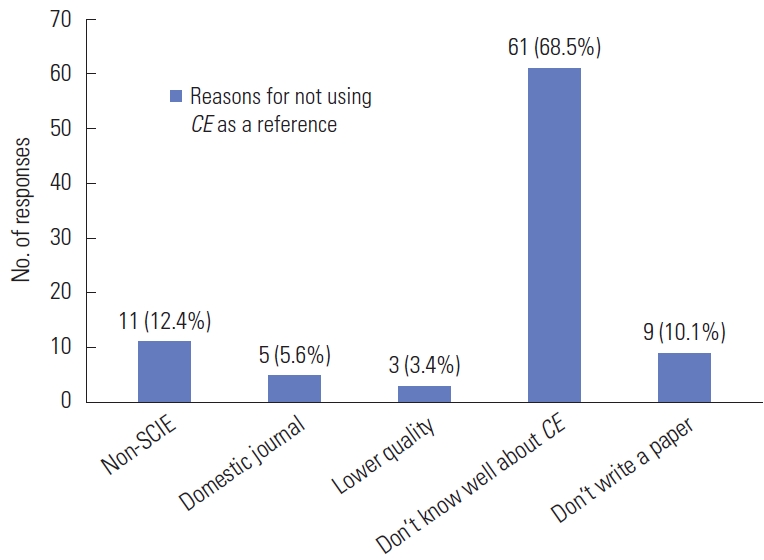
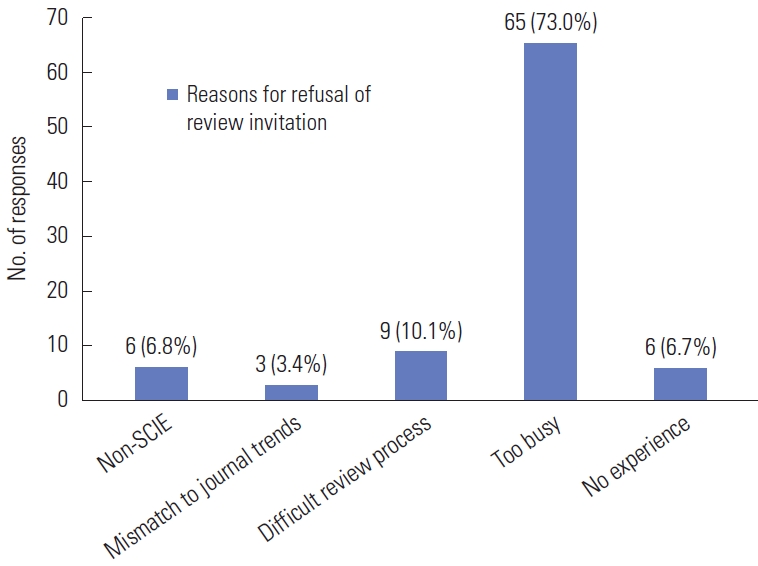

- 1. Kim GH, Kwon KA, Park DH, Han J. Editors’ choice of noteworthy Clinical Endoscopy publications in the first decade. Clin Endosc 2021;54:633-40.https://doi.org/10.5946/ce.202216. ArticlePubMedPMC
- 2. Lee J, Yoo JJ. The current state of graphical abstracts and how to create good graphical abstracts. Sci Ed 2023;10:19-26.https://doi.org/10.6087/kcse.293. Article
- 3. Kapoor KK, Tamilmani K, Rana NP, Patil P, Dwivedi YK, Nerur S. Advances in social media research: past, present and future. Inf Syst Front 2018;20:531-58.https://doi.org/10.1007/s10796-017-9810-y. Article
- 4. Yoon JW, Chung EK. An investigation on graphical abstracts use in scholarly articles. Int J Inf Manag 2017;37:1371-9.https://doi.org/10.1016/j.ijinfomgt.2016.09.005. Article
- 5. Jennings R, Seehra J, Cobourne MT. The Journal of Orthodontics: a cross-sectional survey of British Orthodontic Society members. J Orthod 2021;48:101-9.https://doi.org/10.1177/1465312520988549. ArticlePubMedPMC
- 6. Day PC. Readership survey 2013: what you think about our journal. Aviat Space Environ Med 2013;84:639-41.https://doi.org/10.3357/asem.3720.2013. ArticlePubMed
- 7. Søreide K, Winter DC. Global survey of factors influencing choice of surgical journal for manuscript submission. Surgery 2010;147:475-80.https://doi.org/10.1016/j.surg.2009.10.042. ArticlePubMed
- 8. Stott JC. What do readers want from their journal? BDJ readership survey 2002. Br Dent J 2003;194:311-3.https://doi.org/10.1038/sj.bdj.4809942. ArticlePubMed
References
Figure & Data
References
Citations

- Figure
- Related articles
-
- Data sharing attitudes and practices of researchers in Korean government research institutes: a survey-based descriptive study
- Current status and demand for educational activities on publication ethics by academic organizations in Korea: a descriptive study
- Impact and perceived value of the revolutionary advent of artificial intelligence in research and publishing among researchers: a survey-based descriptive study

 KCSE
KCSE
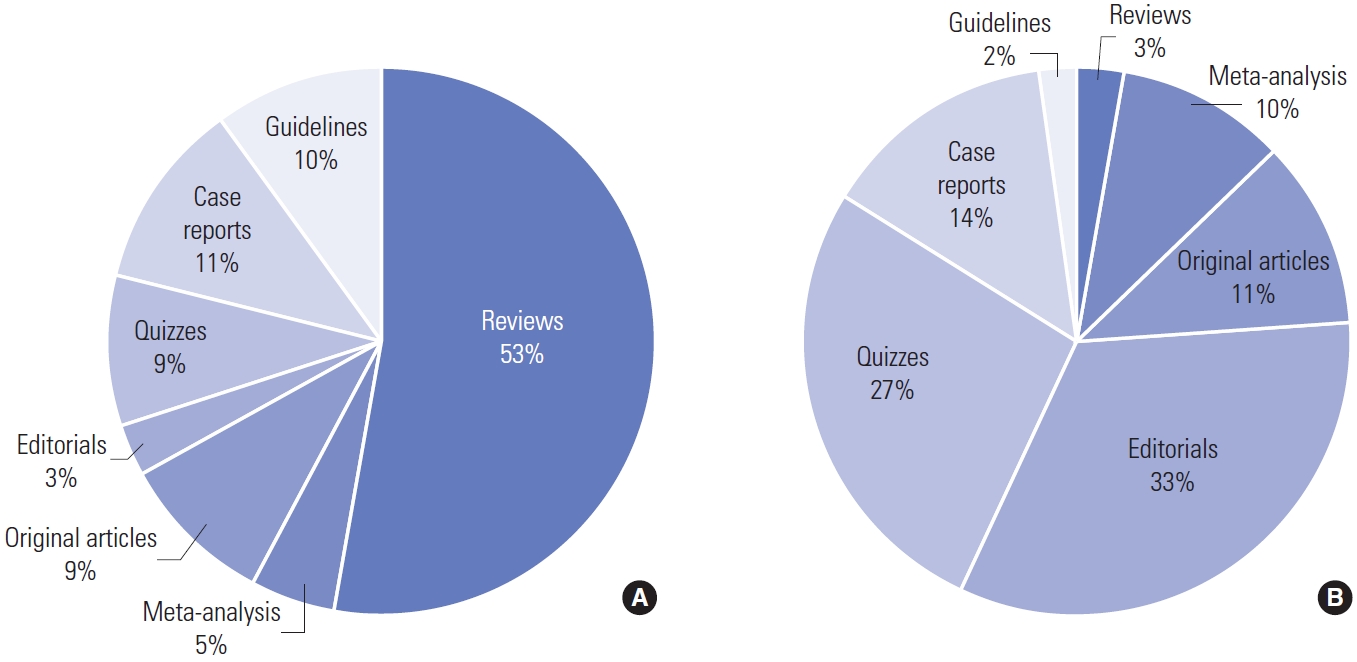
 PubReader
PubReader ePub Link
ePub Link Cite
Cite
